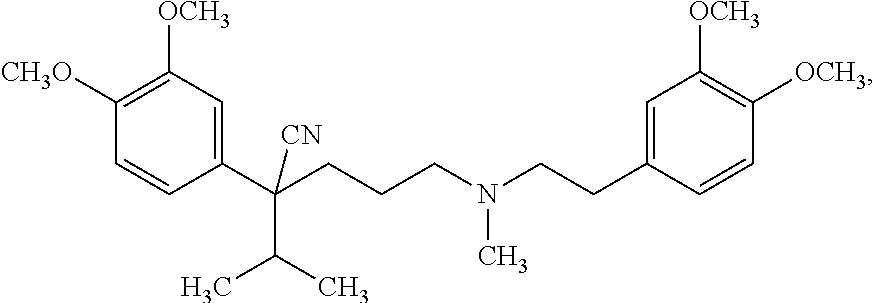Highly water-soluble salts of a short acting phenylalkylamine calcium channel blocker and uses thereof
a short-acting, calcium channel blocker technology, applied in the field of salts including phenylalkylamine compounds, can solve the problems of nasal cavity volumetric limit and limit on the quantity of pharmaceutically active agents, and achieve the effect of rapid targeting of faulty signaling in muscle tissue and high solubility
- Summary
- Abstract
- Description
- Claims
- Application Information
AI Technical Summary
Benefits of technology
Problems solved by technology
Method used
Image
Examples
example 1
methyl 3-(2-((4-cyano-4-(3,4-dimethoxyphenyl)-5-methylhexyl)(methyl)amino)ethyl)benzoate
Part I: Synthesis of 5-Bromo-2-(3,4-dimethoxyphenyl)-2-isopropylpentanenitrile
[0088]
[0089]Method A, Step 1:
[0090]To a solution of 9.99 g (56.4 mmol) of (3,4-Dimethoxyphenyl)acetonitrile in 141 mL of tetrahydrofuran (THF) at −30° C., was slowly added 56.4 mL (56.4 mmol) of sodium bis(trimethylsilyl)amide (NaHMDS, 1.0 M in THF). The mixture was stirred at −30° C. for 10 minutes and 10.6 mL (113.0 mmol) of 2-bromopropane was added. The mixture was heated to reflux for 2 hours (h) then left at 22° C. for about 16 h. A saturated aqueous solution of NH4Cl was added and the mixture was extracted with ethyl acetate. The organic layer was washed with brine, dried (Na2SO4), filtered and evaporated. The residue was purified by flash chromatography on silica gel eluting first with hexane and then gradually increasing to 15% ethyl acetate / hexane to give 2-(3,4-dimethoxyphenyl)-3-methylbutanenitrile as an oil....
example 2
ted Solution of Acetate Salt of Compound I
[0103]A concentrated aqueous solution of the acetate salt of compound I is formed according to the following protocol:
[0104]An aqueous solution of 7.5 M sulfuric acid is first made by diluting concentrated sulfuric acid in water and manually mixing in a sealed bottle, periodically venting the pressure by releasing the bottle cap. Separately, 175±1.0 g of compound I is dispensed from a pre-heated container into a glass bottle and maintained at a temperature of 50±2° C. in a water bath. Next, 96.7±0.2 mL of a 4.0 M acetic acid solution is added to compound I, followed by 83.3 mL±0.2 mL of a 31.8 mM solution of EDTA. The mixture containing the (−) enantiomer (S-enantiomer) of compound I is maintained at 50±2° C. and stirred using a magnetic stir bar during both additions. Heating and stirring is continued until the compound appears to be fully dispersed throughout the mixture.
[0105]Upon complete dispersion of compound I, the solution of 7.5 M s...
example 3
inistration of Compound I
[0107]A patient experiencing an episode of PSVT can use a nasal delivery system containing the acetate or methanesulfonate salt of compound I in order to nasally self-administer a therapeutically effective amount of compound I and alleviate the symptoms of this episode. At the onset of an episode of PSVT, a patient can hold the nasal delivery system up to the nose, such that the applicator of the system is inserted into the nasal cavity. The nasal delivery system is typically held between the second and third fingers, and the patient's thumb is placed on the actuator. This process is similar to the use of commercially available nasal delivery systems such as those used to deliver such drugs as Imitrex® (sumatriptan), sold by GlaxoSmithKline (Brentford, UK) and Zomig® (zolmitriptan), sold by Impax Pharmaceuticals (Hayward, Calif., USA). The patient can then apply pressure to the actuator, which forces the liquid solution containing the dissolved acetate or me...
PUM
| Property | Measurement | Unit |
|---|---|---|
| concentration | aaaaa | aaaaa |
| concentration | aaaaa | aaaaa |
| concentration | aaaaa | aaaaa |
Abstract
Description
Claims
Application Information
 Login to View More
Login to View More - R&D
- Intellectual Property
- Life Sciences
- Materials
- Tech Scout
- Unparalleled Data Quality
- Higher Quality Content
- 60% Fewer Hallucinations
Browse by: Latest US Patents, China's latest patents, Technical Efficacy Thesaurus, Application Domain, Technology Topic, Popular Technical Reports.
© 2025 PatSnap. All rights reserved.Legal|Privacy policy|Modern Slavery Act Transparency Statement|Sitemap|About US| Contact US: help@patsnap.com



